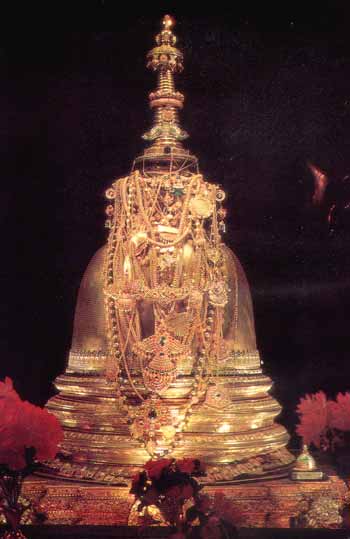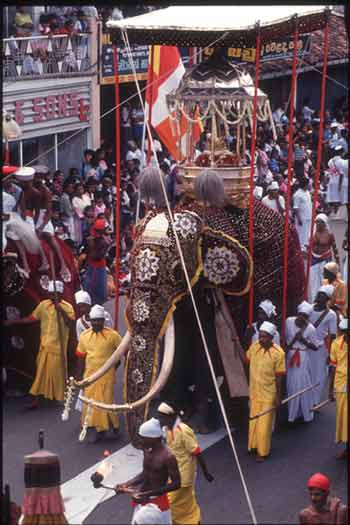
|
||||||||||
|
| ||||||||||
The Significance of Esala Poyaby A.G.S. KariyawasamEsala Poya commemorates several important events in the history of Buddhism Prominent events associated with Esala Buddha's preaching of his First Sermon, the Dhammacakkappavattana Sutta, to the five ascetics took place at the ‘Deer Park', near Benares, on an Esala poya day thereby inaugurating his public ministry. The other noteworthy events connected with this day include the conception of the Bodhisatta in the womb of Queen Maya, his Great Renunciation, the performance of the Twin Miracle (yamaka-patihariya), and his preaching the Abhidhamma for the first time in the Tavatimsa heaven. An additional factor that enhances the value of this poya to Sri Lanka is the first local ordination of a Sri Lankan, when Prince Arittha, the nephew of the king, entered the Order at Anuradhapura, under Arahant Mahinda, following the introduction of Buddhism. On this day there also took place the laying of the foundation for the celebrated dagoba, the Mahastupa or the Ruwanvelisaya and also its enshrinement of relics by King Dutugemunu. It is owing to the combination of all these events that the Sinhala Buddhists fittingly observe this day ceremonially by holding Esala festivals throughout the island, giving pride of place to the internationally famous Kandy Esala Perahera. The Esala pageantThe term perahera, primarily meaning 'procession', signifies a popular Buddhist ceremony replete with many rituals, commencing and culminating respectively with the kap-planting and the water-cutting ceremonies. These two ceremonies are respectively the introductory and the concluding rites of the annual Esala festivals, held in July and August in various parts of the island. They are essentially connected with deities, either to invoke their blessings or to give thanks to them for favours received. During this period every year, such religious festivals are held in almost all the religious centres of Sri Lanka where there are abodes dedicated to various deities. However, the festival par excellence of this category is the Kandy Esala Perahera, which is connected with the Temple of the Tooth and the abodes (devalayas) of the four Hindu deities, Vishnu, Kataragama, Natha, and the Goddess Pattini. The main feature of all these festivals held during this period is the elaborate procession held on the lines of the Kandy Esala Perahera. Both the kap-planting and water-cutting ceremonies are performed by the lay officials (kapuralas) of the devalaya concerned, who are traditionally the experts regarding the details of their performances. These details are generally regarded as secret and are not divulged to the public. The preliminary rite of kap-planting consists of planting a shaft, usually fashioned from a felled young jak tree, which must have borne no fruit. When cut, this tree exudes a white sap which is regarded as a symbol of prosperity. Even felling the tree is done with several attendant rituals at an auspicious time. The trunk is divided into four, one for each of the devalayas, where it is carried with drums in attendance. On the day of the new moon, at an auspicious hour (nakata), the 'kaps' thus prepared are set up in the ground in a special place decorated with leaves, flowers, and fruits. For five nights small processions are conducted within the devalaya precincts around the consecrated kaps. Sometimes benedictory stanzas are chanted by monks. This rite of kap is a kind of vow that the Esala festival, consisting mainly of the perahera, will be held successfully. It is also an invitation to the deities to be present during the festival, providing the necessary protection for its successful performance. In this sense it is this ritual that inaugurates the festival. The water-cutting ceremony (diya-kapum-mangalyaya), which is the concluding ritual of the Esala festival, is performed in the early hours of the day following the final perahera. The Kapurala proceeds on a caparisoned elephant to a selected place along a river bank. He would either go to a selected spot in the river by boat or wade through the water to a particular spot and after drawing a magic circle on the water with the sword he carries, 'cuts' the water and fills the vessel he carried there with water from that spot. Before doing so he empties the water that he took in this same manner the previous year. He then returns to the devalaya, and the vessel of water is kept there until the following year's water cutting ritual which is performed in an identical manner. This is believed to be a rain-making ceremony of sympathetic magic, which type of ritual is quite common in agrarian societies the world over. The Buddhists seem to have adopted this to suit their purposes. The annual Esala Perahera in Kandy, is the most colourful traditional procession in the country. It is the prototype of the other peraheras held elsewhere in the island in such places as Kataragama, Aluthnuwara, Lankatilaka, Bellanwila, Devinuwara, etc. The Kandy Perahera has been held with state patronage from the time the Tooth Relic was brought to Sri Lanka from India in the 4th century AD. Although periodically there have been intermittent breaks due to unsettled political conditions, the festival was never neglected intentionally. This had been so even during colonial times. Respected as the palladium of Sinhala royalty, the relic had been accommodated in different parts of the country, depending on the change of the capital city. Ultimately it came to stay in Kandy, which was the last royal seat of the Sinhala people. ‘Vas' and EsalaEsala poya assumes prominence for yet another ritual of the Sri Lankan Buddhists. This is the annual rains retreat of the monks, 'Vas', which commences on the day following the Esala full moon. On the next poya day, Nikini (August), those monks who failed to commence the normal Vas on the day following Esala Poya, are allowed to enter the 'late Vas'. This article is an extract from the book Buddhist Ceremonies and Rituals of Sri Lanka by A.G.S. Kariyawasam Courtesy: The Daily Mirror Features of Monday, July 6, 2009
|

